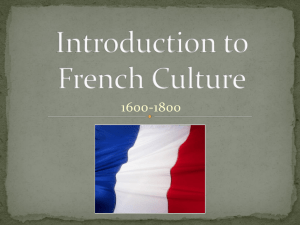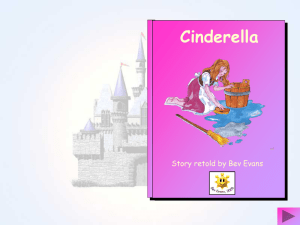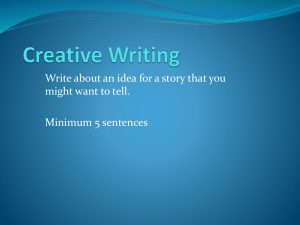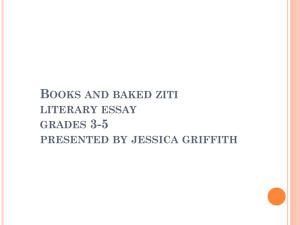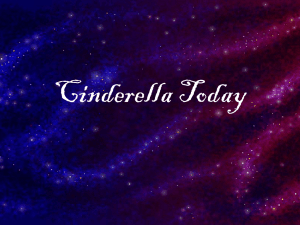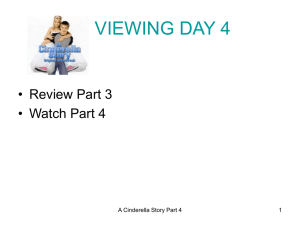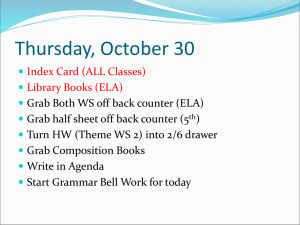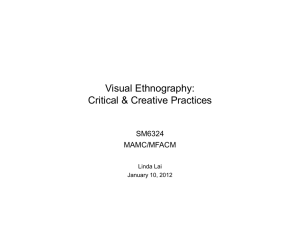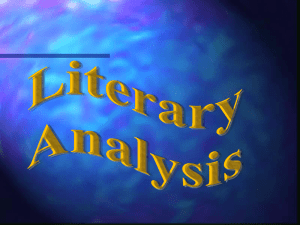File
advertisement
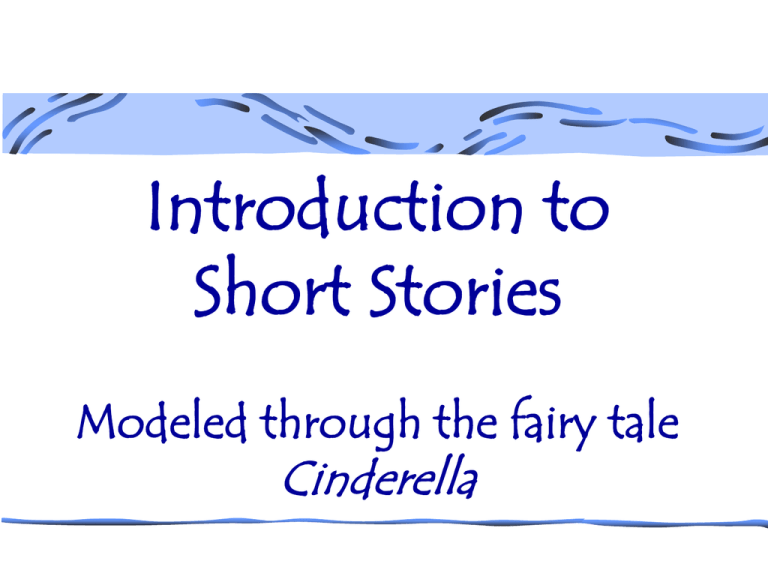
Introduction to Short Stories Modeled through the fairy tale Cinderella CINDERELLA Once upon a time, there was a beautiful girl named Cinderella. She lived with her wicked stepmother and two stepsisters. CINDERELLA They treated Cinderella very badly. CINDERELLA One day, they were invited for a grand ball in the king’s palace. But Cinderella’s stepmother would not let her go. Cinderella was made to sew new party gowns for her stepmother and stepsisters, and curl their hair. They then went to the ball, leaving Cinderella alone at home. Cinderella Cinderella felt very sad and began to cry. Suddenly, a fairy godmother appeared and said, “Don’t cry, Cinderella! I will send you to the ball!” But Cinderella was sad. She said, “I don’t have a gown to wear for the ball!” The fairy godmother waved her magic wand and changed Cinderella’s old clothes into a beautiful new gown! CINDERELLA The fairy godmother then touched Cinderella’s feet with the magic wand. And lo! She had beautiful glass slippers! “How will I go to the grand ball?” asked Cinderella. The fairy godmother found six mice playing near a pumpkin, in the kitchen. She touched them with her magic wand and the mice became four shiny black horses and two coachmen and the pumpkin turned into a golden coach. Cinderella was overjoyed and set off for the ball in the coach drawn by the six black horses. Before leaving, the fairy godmother said, “Cinderella, this magic will only last until midnight! You must reach home by then!” CINDERELLA When Cinderella entered the palace, everybody was struck by her beauty. Nobody, not even Cinderella’s stepmother or stepsisters, knew who she really was in her pretty clothes and shoes. The handsome prince also saw her and fell in love with Cinderella. He went to her and asked, “Do you want to dance?” And Cinderella said, “Yes!” The prince danced with her all night and nobody recognized the beautiful dancer. Cinderella was so happy dancing with the prince that she almost forgot what the fairy godmother had said. At the last moment, Cinderella remembered her fairy godmother’s words and she rushed to go home. “Oh! I must go!” she cried and ran out of the palace. One of her glass slippers came off but Cinderella did not turn back for it. She reached home just as the clock struck twelve. Her coach turned back into a pumpkin, the horses into mice and her fine ball gown into rags. Her stepmother and stepsisters reached home shortly after that. They were talking about the beautiful lady who had been dancing with the prince. CINDERELLA The prince had fallen in love with Cinderella and wanted to find out who the beautiful girl was, but he did not even know her name. He found the glass slipper that had come off Cinderella’s foot as she ran home. The prince said, “I will find her. The lady whose foot fits this slipper will be the one I marry!” The next day, the prince and his servants took the glass slipper and went to all the houses in the kingdom. They wanted to find the lady whose feet would fit in the slipper. All the women in the kingdom tried the slipper but it would not fit any of them. Cinderella’s stepsisters also tried on the little glass slipper. They tried to squeeze their feet and push hard into the slipper, but the servant was afraid the slipper would break. Cinderella’s stepmother would not let her try the slipper on, but the prince saw her and said, “Let her also try on the slipper!” The slipper fit her perfectly. The prince recognized her from the ball. CINDERELLA He married Cinderella and together they lived happily ever after. SETTING The time and place of a story or play. Answers where and when. CHARACTERS Individuals (people) in a story. A character always has human traits even if he/she/it is not human. PROTAGONIST The main character—the one we focus our attention on as we read. Often, but not always, the hero or “good guy.” The person who sets the plot in motion. ANTAGONIST The character in conflict with the protagonist. Readers often know a limited amount about the antagonist— sometimes just that he or she is the “bad guy.” POINT OF VIEW The point from which the story is told. The person who tells the story is called the narrator. FIRST PERSON The narrator is a character in the story. The reader hears and sees only what the narrator does. Clues: first-person pronouns— I, we, us, my, etc. THIRD PERSON The narrator plays no part in the story; tells the story looking in from the outside. Clues: third-person pronouns— he, she, it, they, them, etc. THIRD PERSON OMNISCIENT An “all knowing” narrator who reveals the thoughts and actions of the characters. May reveal the past, present, and future, and even tell the reader what is happening in other places. THIRD PERSON LIMITED A narrator, who is not a character in the story, zooms in on the thoughts and feelings of just one character. THEME The central idea or insight revealed in a story; the message you get from reading the story The theme can be applied to life. It is NOT the subject of a story. Must be expressed in at least one complete sentence. STATED THEME: directly presented in the story; very rare, though sometimes seen in fables. IMPLIED THEME: reader must determine the theme for himself PLOT The sequence of events in a story Most plots deal with a problem and develop around a conflict CONFLICT A struggle between two forces EXTERNAL CONFLICT: a struggle between a character and an outside force such as another character, nature, society or fate INTERNAL CONFLICT: takes place within the mind of a character who struggles with opposing feelings or with a decision on how to act STAGES OF A PLOT Climax Rising Action Exposition Falling Action Resolution EXPOSITION Introduces the story’s characters, setting & conflict EXPOSITION Example: Once upon a time there lived a girl named Cinderella…she lived with her stepmother and stepsisters. They made her a slave. RISING ACTION Develops the conflict with complications and twists. RISING ACTION Example: Invitations arrives for ball. Cinderella’s stepmother won’t let her go. Cinderella’s fairy godmother sends her to ball. She loses glass slipper. The prince wants to marry the girl with the missing slipper. CLIMAX The turning point in the story when the suspense is greatest. CLIMAX Example: The prince goes from house-to-house trying to find the slipper’s owner, step-sisters try and squeeze in, and finally discovers Cinderella who fits the slipper. FALLING ACTION What happens after the climax FALLING ACTION Example: Cinderella marries the prince. RESOLUTION The struggles are over and the reader knows what will happen to the protagonist. RESOLUTION Example: Cinderella & the prince live happily ever after. The evil stepmother and her daughters were punished for treating Cinderella so badly.
